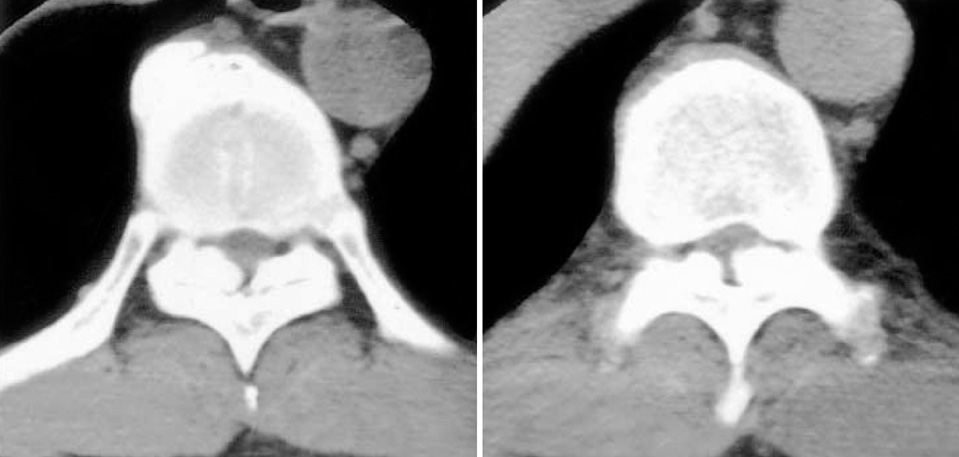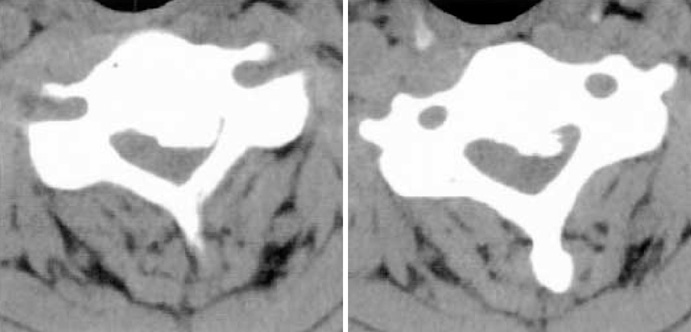J Korean Med Sci.
2004 Aug;19(4):624-626. 10.3346/jkms.2004.19.4.624.
Transient Paraparesis After Laminectomy in a Patient with Multi-Level Ossification of the Spinal Ligament
- Affiliations
-
- 1Department of Neurosurgery, Soonchunhyang University Chonan Hospital, Chonan, Korea. kslshl@schch.co.kr
- KMID: 2157699
- DOI: http://doi.org/10.3346/jkms.2004.19.4.624
Abstract
- Acute neurologic deterioration is not a rare event in the surgical decompression for thoracic spinal stenosis. We report a case of transient paraparesis after decompressive laminectomy in a 50-yr-old male patient with multi-level thoracic ossification of the ligamentum flavum and cervical ossification of the posterior longitudinal ligament. Decompressive laminectomy from T9 to T11 was performed without gross neurological improvement. Two weeks after the first operation, laminoplasty from C4 to C6 and additional decompressive laminectomies of T3, T4, T6, and T8 were performed. Paraparesis developed 3 hr after the second operation, which recovered spontaneously 5 hr thereafter. CT and MRI were immediately performed, but there were no corresponding lesions. Vascular compromise of the borderlines of the arterial supply by microthrombi might be responsible for the paraparesis.
Keyword
MeSH Terms
Figure
Reference
-
1. Chang UK, Choe WJ, Chung CK, Kim HJ. Surgical treatment for thoracic spinal stenosis. Spinal Cord. 2001. 39:362–369.
Article2. Bacher T, Schiltenwolf M, Niethard FU, Paeslack V. The risk of paraplegia through medical treatment. Spinal Cord. 1999. 37:172–182.
Article3. Cho YH, Moon SM, Roh SW, Joen SR, Rhim SC. Surgical outcome and prognostic factors of ossified ligamentum flavum of the thoracic spine. J Korean Neurosurg Soc. 2002. 32:424–430.4. Kim J, Cho JH, Oh HK. Thoracic myelopathy due to ossification of ligamentum flavum: three cases report. J Korean Soc Spine Surg. 2002. 9:257–261.5. Kim YS, Jin BH, Yoon DH, Cho YE, Chin DK. Thoracic stenosis secondary to ossification of the ligamentum flavum. J Korean Neurosurg Soc. 1997. 26:971–979.6. Park YS, Lee IH, Kim MK. A case of myelopathy due to the nodular ossification of the ligamentum flavum of thoracic spine in diffuse idiopathic skeletal hyperostosis. J Korean Rheum Assoc. 2000. 7:174–178.7. Vasudevan A, Knuckey NW. Ossification of the ligamentum flavum. J Clin Neurosci. 2002. 9:311–313.
Article8. Yoo MC, Kim KT, Kim YW, Kim HS, Jeon MH. Sacral radiculopathy due to ossification of ligamentum flavum and posterior longitudinal ligament: one case report. J Korean Orthop Assoc. 1998. 33:834–839.
Article9. Young WF, Baron E. Acute neurologic deterioration after surgical treatment for thoracic spinal stenosis. J Clin Neurosci. 2001. 8:129–132.
Article10. Li KK, Chung OM, Chang YP, So YC. Myelopathy caused by ossification of ligamentum flavum. Spine. 2002. 27:E308–E312.
Article11. Tribus CB. Transient paraparesis: a complication of the surgical management of Scheuermann's kyphosis secondary to thoracic stenosis. Spine. 2001. 26:1086–1089.12. Valls PL, Naul LG, Kanter SL. Paraplegia after a routine lumbar laminectomy: report of a rare complication and successful management. Neurosurgery. 1990. 27:638–640.
Article13. Hentschel SJ, Woolfenden AR, Fairholm DJ. Resolution of spontaneous spinal epidural hematoma without surgery: report of two cases. Spine. 2001. 26:E525–E527.14. Gerancher JC, Waterer R, Middleton J. Transient paraparesis after postdural puncture spinal hematoma in a patient receiving ketorolac. Anesthesiology. 1997. 86:490–494.
Article15. Tanaka T, Uemura K, Sugiura M, Ohishi H, Tomita M, Nagasaki F, Matsuda S, Kobayashi R, Fukaya T. Transient paraplegia caused by acute aortic dissection. Neurol Med Chir (Tokyo). 1990. 30:54–58.
Article16. Kim C, Blank J, McClain BC. Transient paraparesis after general anesthesia in a patient in the prone position. Anesthesiology. 1994. 81:775–777.
Article17. Chiapparini L, Sghirlanzoni A, Pareyson D, Savoiardo M. Imaging and outcome in severe complications of lumbar epidural anesthesia: report of 16 cases. Neuroradiology. 2000. 42:564–571.18. Shiokawa K, Hanakita J, Suwa H, Saiki M, Oda M, Kajiwara M. Clinical analysis and prognostic study of ossified ligamentum flavum of the thoracic spine. J Neurosurg. 2001. 94:S221–S226.
Article19. Deyo RA, Cherkin DC, Loeser JD, Bigos SJ, Ciol MA. Morbidity and mortality in association with operations on the lumbar spine. The influence of age, diagnosis, and procedure. J Bone Joint Surg Am. 1992. 74:536–543.
Article
- Full Text Links
- Actions
-
Cited
- CITED
-
- Close
- Share
- Similar articles
-
- Acute Spinal Epidural Hematoma Following Unilateral Laminectomy for Bilateral Decompression
- Sacral Radiculopathy Due to Ossification of Ligamentum Flavum and Posterior Longitudinal Ligament: One Case Report
- Cervical Myelopathy due to Ossification of Yellow Ligament in a Patient with Reiter's Syndrome
- Symptomatic Myelopathy Caused by Ossification of the Yellow Ligament
- A Diffuse Idiopathic Skeletal Hyperostosis Patient Associated with Ossification of Thoracic Ligamentum Flavum: A Case Report



